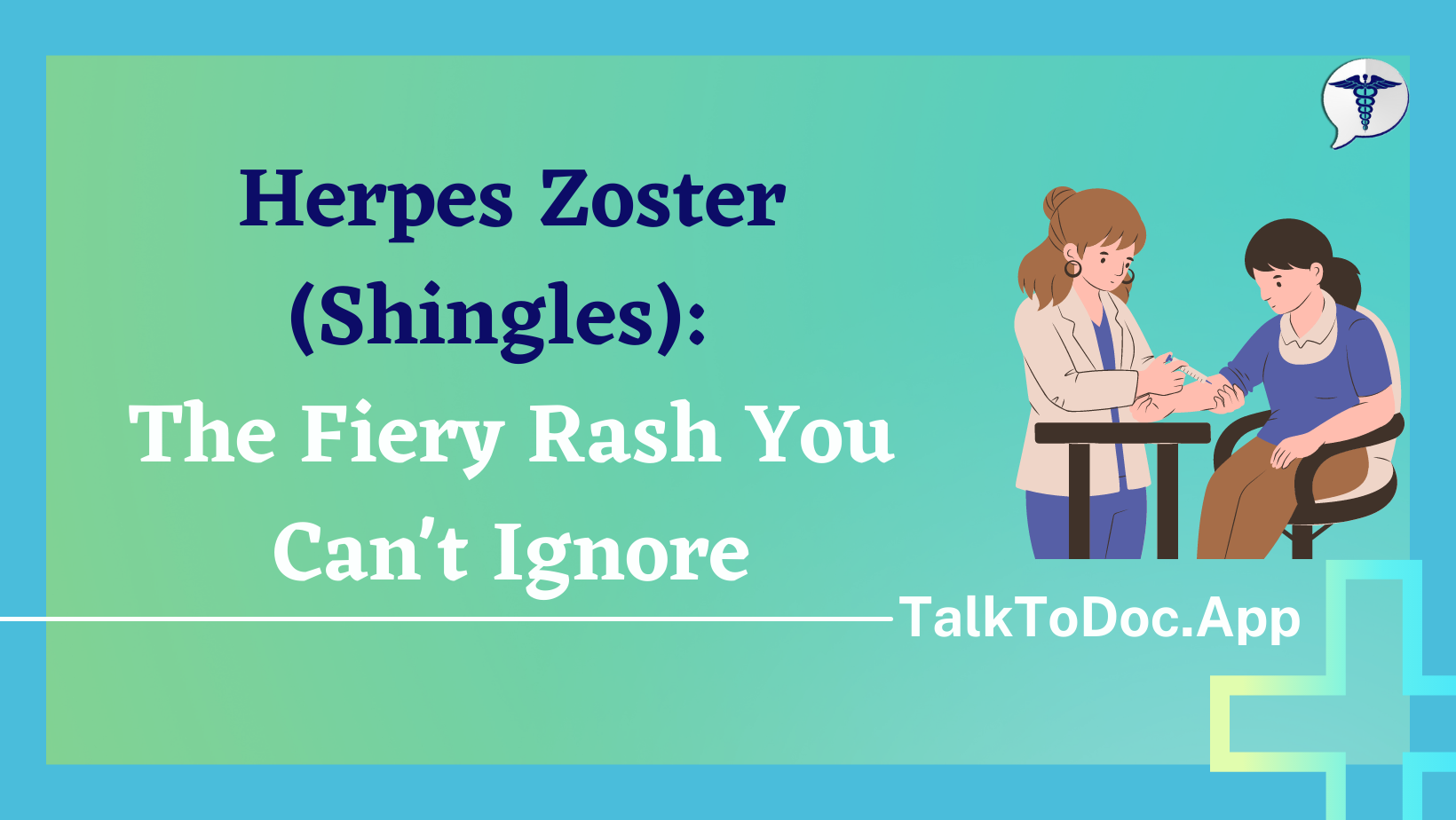Herpes Zoster, also known as Shingles, is a viral infection caused by the varicella-zoster virus (VZV), which is the same virus that causes chickenpox. Shingles typically present as a painful rash that occurs in a specific area of the body. In this article, we will discuss the risk factors, causes, types, signs and symptoms, investigations, treatment, prevention, and lifestyle changes associated with shingles, based on guidelines provided by the World Health Organization (WHO).
Risk Factors
- Age: Shingles primarily affect older adults, typically those over the age of 50. Advancing age weakens the immune system, making individuals more susceptible to viral infections.
- History of chickenpox: People who have previously had chickenpox can develop shingles because the varicella-zoster virus remains dormant in the nerve tissues after the initial infection and can reactivate years later.
- Weakened immune system: Conditions such as HIV/AIDS, cancer, or undergoing treatments like chemotherapy or radiation therapy can weaken the immune system, increasing the risk of shingles.
- Stress: Prolonged periods of stress can impair immune function and potentially trigger a shingles outbreak.
Causes
Shingles are caused by the reactivation of the varicella-zoster virus, which lies dormant in nerve tissues after a previous chickenpox infection. When the virus reactivates, it travels along the nerve pathways to the skin, leading to the characteristic rash and associated symptoms.
Types
- Herpes Zoster Ophthalmicus: When shingles affect the ophthalmic nerve in the eye, it can cause eye-related symptoms, such as eye pain, redness, and sensitivity to light.
- Herpes Zoster Oticus: Shingles involving the facial nerve can lead to symptoms like ear pain, facial weakness, and sometimes hearing loss.
Signs and Symptoms
- Pain and tingling: The affected area may experience pain, tingling, or burning sensations even before the rash appears.
- Rash: A rash appears as a band or cluster of red, fluid-filled blisters that develop on one side of the body. The rash typically follows the path of a nerve and can be accompanied by itching.
- Itching: The rash may be accompanied by intense itching, which can be distressing.
- Other symptoms: Fever, headache, fatigue, and general malaise may be present.
Investigations
In most cases, the diagnosis of shingles can be made based on the characteristic rash and associated symptoms. However, if the diagnosis is uncertain, the following investigations may be performed:
- Viral culture: A sample from the rash may be collected and tested to identify the presence of the varicella-zoster virus.
- Polymerase chain reaction (PCR): This test can detect the genetic material of the virus in the sample, providing a more sensitive and specific diagnosis.
Treatment
Early treatment can help alleviate the symptoms and reduce the risk of complications. The primary goals of treatment include:
- Antiviral medications: Oral antiviral drugs, such as acyclovir, valacyclovir, or famciclovir, can help reduce the severity and duration of shingles if started within 72 hours of rash onset.
- Pain management: Over-the-counter pain relievers, such as acetaminophen or ibuprofen, can help manage the pain associated with shingles. In some cases, prescription pain medications or topical anesthetics may be necessary.
- Calamine lotion or wet compresses: Applying calamine lotion or cool, wet compresses to the affected area can help soothe itching and promote healing.
Prevention
Vaccination is the most effective way to prevent shingles. The WHO recommends the use of the herpes zoster vaccine in individuals aged 50 years and older. The vaccine, known as Zoster Vaccine Live, significantly reduces the risk of developing shingles and postherpetic neuralgia, a complication of shingles characterized by persistent nerve pain.
Lifestyle Changes
In addition to vaccination, certain lifestyle changes can help prevent shingles or reduce the severity of symptoms:
- Stress management: Engaging in stress-reducing activities like exercise, meditation, or hobbies can help boost the immune system and lower the risk of shingles.
- Healthy habits: Maintaining a balanced diet, getting regular exercise, and getting enough sleep can support overall immune function.
- Avoidance of high-risk individuals: Individuals with active shingles can transmit the virus to individuals who have not had chickenpox. It is important to avoid close contact with high-risk individuals, such as newborns, pregnant women, and individuals with weakened immune systems.
Example: John, a 65-year-old man with a history of chickenpox, developed shingles on his left side of the abdomen. He experienced intense pain, followed by the appearance of a rash. Recognizing the symptoms, John visited his healthcare provider, who diagnosed him with shingles based on the characteristic rash and symptoms. He was prescribed antiviral medication and pain relievers to manage the symptoms. Additionally, his healthcare provider recommended getting the herpes zoster vaccine to prevent future episodes.
shingles is a viral infection caused by the reactivation of the varicella-zoster virus. Understanding the risk factors, causes, types, signs and symptoms, investigations, treatment, prevention, and lifestyle changes associated with shingles can help individuals recognize the condition, seek appropriate medical care, and take necessary precautions to prevent its occurrence. Following WHO guidelines, such as vaccination and adopting a healthy lifestyle, can significantly reduce the burden of shingles and its complications.
